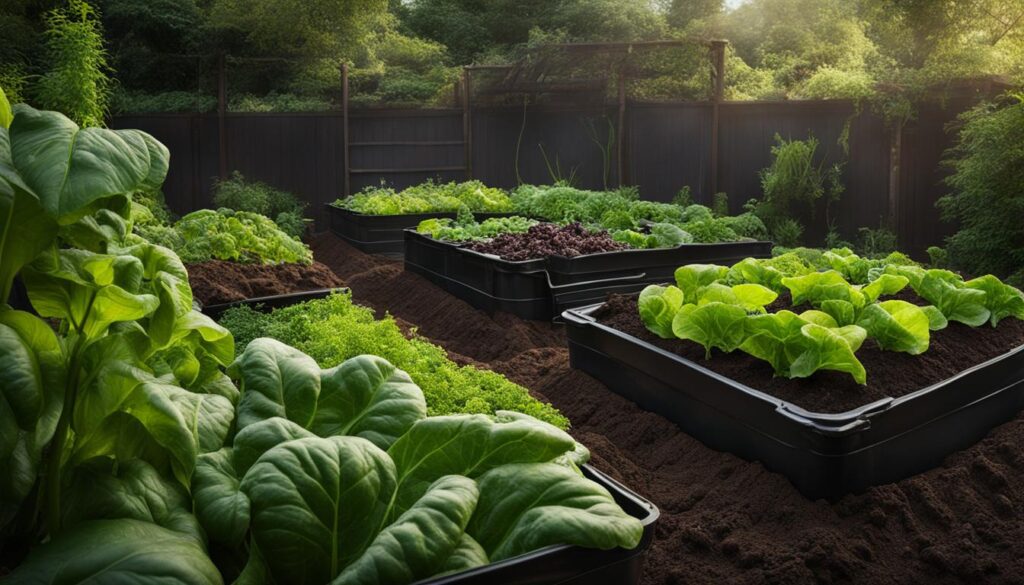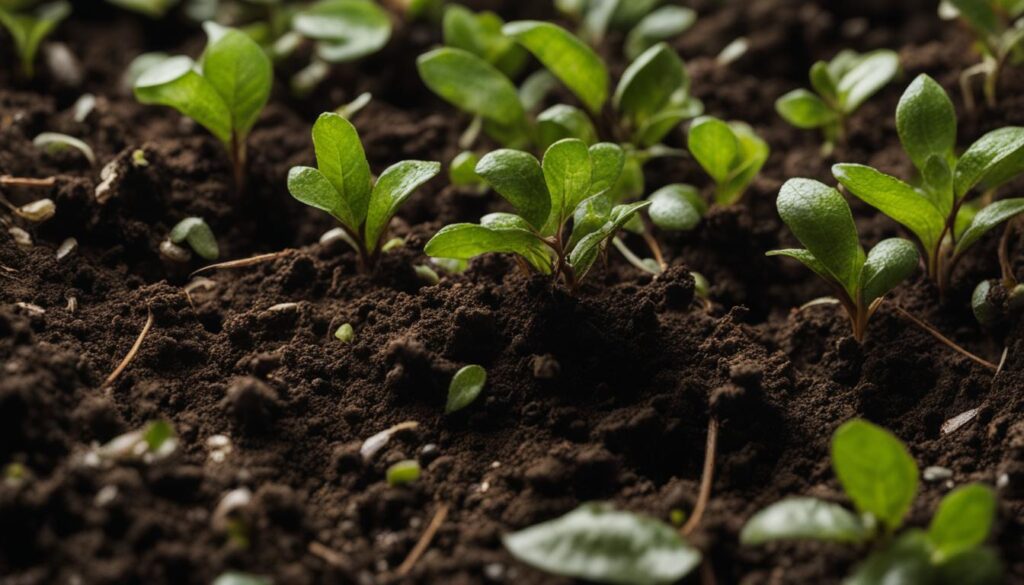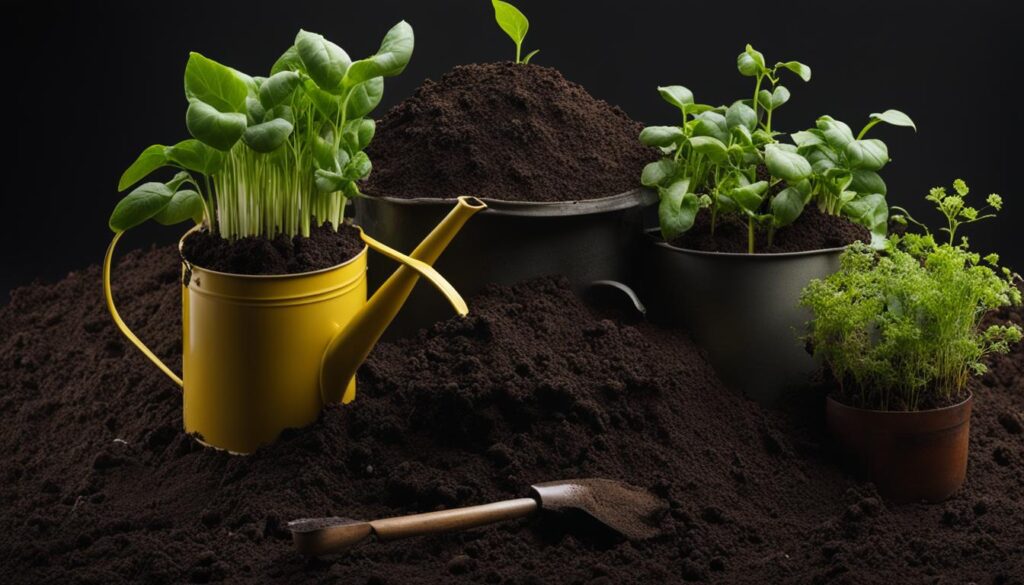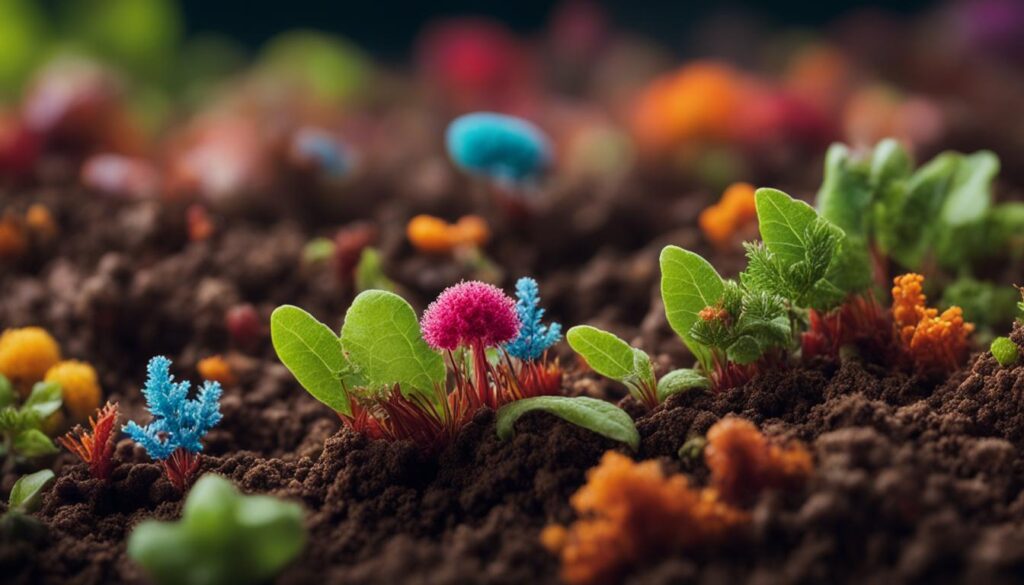Are you looking to create a thriving garden while conserving water? The secret lies in unlocking the power of soil organic matter. By understanding the importance of soil organic matter and nurturing your plants with care, you can create a sustainable and water-wise garden ecosystem.
Soil organic matter is the key to successful organic gardening and water-wise gardens. It increases biodiversity, improves soil health, and helps conserve water. By implementing the right techniques, you can nurture your plants and ensure their vitality while making a positive impact on the environment.
Key Takeaways:
- Soil organic matter is essential for successful organic gardening and water-wise gardens.
- Increasing soil organic matter improves soil health and fosters a thriving ecosystem for your plants.
- Transitioning to organic gardening methods gradually improves soil ecology and long-term soil health.
- Incorporating compost into your soil enhances its fertility and supports beneficial microbial populations.
- Maximizing water-holding capacity with organic matter conserves water and ensures optimal plant growth.
Soil Organic Matter: The Foundation for Healthy Plants
When it comes to healthy plants, it all starts with the soil. Soil organic matter is the key to creating a thriving ecosystem for your plants. It acts as the foundation for healthy soil, supporting microbial populations and facilitating nutrient cycling.
Healthy soil is teeming with life, thanks to a diverse community of bacteria, fungi, and other organisms that make up the soil food web. These organisms play a vital role in maintaining soil health by breaking down organic matter and releasing essential nutrients for plants to absorb. By increasing the organic matter content in your soil, you can enhance the microbial activity and promote nutrient availability for your plants.
In addition to supporting microbial populations, soil organic matter also improves soil structure. It acts as a “glue” that holds soil particles together, creating pore spaces for air and water movement. This allows roots to penetrate the soil easily and facilitates better water retention. With healthy soil structure, your plants can access the necessary water and nutrients they need for optimal growth and development.
To maximize the benefits of soil organic matter, incorporate organic amendments like compost or well-rotted manure into your soil. These organic materials will enrich your soil with nutrients, enhance its water-holding capacity, and promote the overall health of your plants. By prioritizing soil organic matter, you are laying the groundwork for a successful and resilient garden.
The Benefits of Soil Organic Matter:
- Improves soil structure and promotes root penetration
- Enhances microbial activity and nutrient cycling
- Increases water-holding capacity and reduces water runoff
- Provides essential nutrients for healthy plant growth
- Supports a thriving soil ecosystem
Quote:
“Soil organic matter acts as the foundation for healthy plants. By nourishing the soil with organic amendments, you create an environment where beneficial microbes thrive, nutrient cycling is optimized, and your plants can reach their full potential.” – Organic Gardening Expert
Table: Soil Organic Matter Levels in Different Soil Types
| Soil Type | Organic Matter Content (%) |
|---|---|
| Sandy Soil | 1-2% |
| Loam Soil | 4-6% |
| Clay Soil | 2-4% |
Transitioning to Organic Gardening for Soil Health
Transitioning from synthetic products to organic gardening methods is a gradual process that requires a shift in mindset. As an organic gardener, you focus on feeding the soil rather than solely relying on synthetic fertilizers. By using organic amendments and “quick-release” organic fertilizers, you can provide the necessary nutrients for your plants while improving the natural soil ecology.
Organic gardening promotes a diverse and thriving soil ecosystem. Synthetic products tend to disrupt the delicate balance of the soil’s microorganisms, leading to imbalances and nutrient deficiencies. Organic amendments, such as compost, manure, and cover crops, replenish the soil with essential nutrients, improve soil structure, and foster beneficial microbial activity.
In addition to nurturing soil health, transitioning to organic gardening also has environmental benefits. Synthetic products can have negative impacts on water quality and wildlife, while organic gardening methods promote sustainability and conservation of natural resources. By embracing organic gardening practices, you can create a healthier and more sustainable garden while minimizing your ecological footprint.
The Benefits of Transitioning to Organic Gardening
“Transitioning to organic gardening methods not only benefits your plants but also contributes to a healthier and more sustainable environment.”
By transitioning to organic gardening, you are not only improving soil health but also providing a safe and healthy environment for yourself, your family, and your pets. Synthetic fertilizers can leach into groundwater, affecting water quality and potentially harming aquatic life. By using organic amendments, you reduce the risk of water contamination and support the overall health of ecosystems.
Organic gardening also enhances biodiversity by promoting the growth of beneficial insects, pollinators, and other wildlife. By avoiding the use of synthetic pesticides and herbicides, you create a balanced ecosystem where beneficial insects can thrive and naturally control pests. This approach reduces the need for chemical interventions and supports the health of the entire garden ecosystem.
Transitioning to organic gardening requires patience and a commitment to nurturing soil health. But the rewards are well worth the effort. By embracing organic gardening methods, you can create a vibrant and sustainable garden that flourishes with healthy, nutrient-rich plants.
Table: Synthetic Products vs. Organic Amendments
| Synthetic Products | Organic Amendments |
|---|---|
| Can disrupt soil microorganisms | Fosters beneficial microbial activity |
| Can leach into groundwater | Reduces the risk of water contamination |
| May harm beneficial insects | Promotes biodiversity and natural pest control |
| Requires frequent application | Slow-release nutrients, reducing the need for constant fertilization |
| Can result in imbalanced soil fertility | Provides a balanced nutrient profile and improves soil structure |
The Importance of Organic Matter in Soil
Organic matter is a critical component of soil health and fertility. It is composed of various organic materials, such as decomposed plant and animal residues, that provide essential nutrients for plants. When soil lacks organic matter, it becomes barren and nutrient-deficient, leading to poor plant growth and reduced crop yields.
One of the primary benefits of organic matter in soil is its ability to improve soil structure. Organic matter acts as a binding agent, holding soil particles together and creating aggregates. These aggregates create pore spaces in the soil, allowing for better air and water movement. This promotes root development and prevents soil compaction, which can hinder plant growth.
Moreover, organic matter plays a crucial role in nutrient availability. It acts as a reservoir for essential plant nutrients, such as nitrogen, phosphorus, and potassium. When organic matter decomposes, these nutrients are released into the soil, becoming available for plant uptake. This ensures that plants have an adequate supply of nutrients for healthy growth and development.
The Benefits of Organic Matter in Soil:
- Improves soil structure and prevents compaction
- Enhances water infiltration and retention
- Provides a source of essential plant nutrients
- Promotes beneficial soil microbial activity
- Reduces soil erosion
By incorporating organic matter into the soil through practices like composting, cover cropping, and the addition of organic amendments, gardeners can reap these benefits and create a thriving, nutrient-rich environment for their plants.
| Organic Matter Benefits | |
|---|---|
| Improved Soil Structure | Organic matter acts as a binding agent, creating aggregates that improve soil structure and prevent compaction. |
| Enhanced Water Infiltration and Retention | Organic matter increases the soil’s ability to absorb and retain water, reducing the risk of drought stress for plants. |
| Source of Essential Plant Nutrients | As organic matter decomposes, it releases nutrients that are vital for plant growth and development. |
| Promotes Beneficial Soil Microbial Activity | Organic matter provides a food source for beneficial soil microbes, which play a crucial role in nutrient cycling and disease suppression. |
| Reduces Soil Erosion | The presence of organic matter helps to bind soil particles together, reducing the risk of erosion caused by wind and water. |
“Organic matter is the lifeblood of healthy soil. It nourishes plants, improves soil structure, and supports a diverse community of beneficial soil organisms. By prioritizing the addition of organic matter, gardeners can create a vibrant and productive garden ecosystem.”
The Power of Compost in Soil Health
Compost is a game-changer when it comes to soil health. It is a nutrient-rich amendment that can greatly enhance the fertility of your soil. Compost is teeming with microbial populations that contribute to nutrient cycling, disease suppression, and overall soil health. By incorporating compost into your garden, you can provide a steady supply of organic matter and essential nutrients, creating the ideal conditions for plant growth.
Using compost in your garden is easy. You can add it to your soil before seeding or transplanting, ensuring that your plants start off with nutrient-rich soil. Another option is to use compost as a mulch during the growing season. Applying a layer of compost around your plants helps retain moisture, suppress weeds, and feed the soil. Additionally, compost can be incorporated into potting and seedling mix, providing a nutrient boost for young plants.
When it comes to soil fertility, compost is a superstar. It improves soil structure, increases water-holding capacity, and enhances nutrient availability. By incorporating compost into your gardening routine, you can reduce the need for synthetic fertilizers and promote a more sustainable approach to plant care. Start harnessing the power of compost today and watch your garden thrive.
Benefits of Compost:
- Enhances soil fertility by providing essential nutrients
- Promotes the growth of beneficial microbial populations
- Improves soil structure and water-holding capacity
- Reduces the need for synthetic fertilizers
- Supports sustainable gardening practices
Quick Tips for Using Compost:
- Add compost to your soil before planting or use it as a mulch during the growing season.
- Regularly incorporate compost into potting and seedling mix for young plants.
- Apply a layer of compost to improve soil structure and water retention.
- Use compost in your garden beds, containers, and raised beds for optimal results.
Table: Comparison of Soil Parameters with and without Compost
| Soil Parameter | With Compost | Without Compost |
|---|---|---|
| Nutrient Content | High | Low |
| Microbial Populations | Abundant | Limited |
| Water-Holding Capacity | High | Low |
| Soil Structure | Improved | Compacted |
Beneficial Soil Microbes: Allies for Plant Health
The soil ecosystem is home to a diverse community of beneficial soil microbes that contribute to plant health and vitality. These microbes, particularly bacteria and fungi, form symbiotic relationships with plants, offering a wide range of benefits. They play a crucial role in improving nutrient uptake, protecting against environmental stressors, and producing plant growth hormones. By promoting the growth and activity of these beneficial soil microbes, gardeners can create an optimized environment for plant growth and overall garden health.
Beneficial soil microbes enhance nutrient uptake by forming mutually beneficial relationships with plant roots. For example, mycorrhizal fungi establish a symbiotic association with the roots of most plants. They extend the root system, increasing the surface area for nutrient absorption and aiding in the uptake of essential elements like phosphorus. Other types of soil bacteria, such as nitrogen-fixing bacteria, convert atmospheric nitrogen into a form that plants can utilize, enhancing nitrogen availability for plant growth.
Furthermore, beneficial soil microbes help plants combat environmental stressors. They can improve drought tolerance by enhancing root growth and enabling plants to access water more efficiently. Additionally, these microbes can protect plants against diseases and pests by competing with harmful organisms for resources or producing compounds that inhibit their growth. By fostering a diverse and active soil microbial community, gardeners can strengthen plant resilience and reduce the reliance on chemical interventions.
In summary, beneficial soil microbes are essential allies for plant health and play a vital role in nutrient uptake, stress tolerance, and disease defense. By prioritizing the promotion of these beneficial microorganisms, gardeners can create a thriving soil ecosystem that supports the growth and vitality of their plants.
Maximizing Water-Holding Capacity with Organic Matter
The addition of organic matter to soil is a powerful strategy for improving water-holding capacity. Organic matter acts like a sponge, capable of holding 80-90% of its weight in water. This means that by increasing the organic matter content of your soil, you can reduce runoff, enhance soil moisture levels, and conserve water in your garden.
One way to maximize water-holding capacity is by maintaining a layer of organic matter as a soil cover. This can be achieved by mulching your garden beds with materials such as straw, wood chips, or compost. Not only will this help to retain moisture in the soil, but it will also provide insulation and protection against temperature extremes.
Another method is to incorporate organic amendments into your soil. These amendments, such as compost or well-rotted manure, help to improve soil structure and create pore spaces that can hold water. They also contribute to the overall fertility of the soil, ensuring that your plants have access to essential nutrients.
Proper irrigation techniques are also essential for maximizing water-holding capacity. By watering deeply and infrequently, you encourage the roots of your plants to grow deeper into the soil, where they can access the water held by the organic matter. Additionally, using techniques such as drip irrigation or soaker hoses can minimize water loss through evaporation and ensure that water is delivered directly to the root zone.
Table: Comparison of Water-Holding Capacity with and without Organic Matter
| Soil without Organic Matter | Soil with Organic Matter | |
|---|---|---|
| Water-Holding Capacity | Low | High |
| Runoff | High | Low |
| Soil Moisture | Quick to dry out | Retains moisture |
| Water Conservation | Inefficient | Efficient |
The table above highlights the significant differences in water-holding capacity, runoff, soil moisture, and water conservation between soil with and without organic matter. By utilizing organic matter, you can create a water-wise garden that thrives even in drought conditions, while also reducing the need for frequent watering and conserving water resources.
Soil Health Benefits for Farmers and the Environment
Improving soil health has numerous benefits for farmers and the environment. When soil is healthy, it leads to increased productivity and profits for farmers while also protecting natural resources. By implementing soil health management practices, farmers can optimize their inputs, sustain their outputs, and build resilience in their agricultural systems.
A key benefit of soil health is increased productivity. Healthy soils improve soil structure, making it easier for plant roots to access essential nutrients and water. This leads to higher crop yields and increased profits for farmers. Additionally, healthy soils support a diverse array of beneficial soil organisms, such as bacteria and fungi, which contribute to nutrient cycling and disease suppression.
Another important benefit of soil health is its role in natural resource protection. Healthy soils reduce runoff and prevent erosion, which helps to preserve water quality in nearby streams and rivers. By building healthy soils, farmers can actively contribute to the conservation of natural resources, promoting sustainable farming practices.
Table: Comparing Soil Health Benefits
| Benefits | Farmers | Environment |
|---|---|---|
| Increased Productivity | Increase in crop yields and profits | N/A |
| Profitability | Higher profits due to increased productivity | N/A |
| Resource Protection | N/A | Reduction in runoff and erosion |
“Improving soil health not only benefits farmers but also plays a crucial role in conserving natural resources, promoting sustainable farming practices, and ensuring a healthier environment for future generations.”
By recognizing the importance of soil health and implementing practices to improve it, farmers can create a positive impact on both their agricultural operations and the surrounding environment. Through sustainable soil management, increased productivity, higher profits, and natural resource protection can be achieved, contributing to a more sustainable and resilient agricultural system.
The Basics of Soil Health Management
When it comes to maintaining healthy soil, there are a few key principles to keep in mind. By implementing soil health management practices, you can minimize disturbance, maximize biodiversity, and maximize soil cover. These practices not only improve soil health but also contribute to the overall sustainability and resilience of your garden.
Minimize Disturbance
To promote soil health, it’s important to minimize soil disturbance. This means reducing or eliminating practices such as excessive tilling or deep digging. These actions can disrupt the natural structure of the soil and harm beneficial soil organisms. Instead, opt for low-impact cultivation methods like no-till gardening or shallow cultivation. By minimizing disturbance, you can preserve soil structure and create a stable environment for soil life to thrive.
Maximize Biodiversity
Biodiversity is essential for a healthy soil ecosystem. By planting a diverse range of crops and cover crops, you can maximize biodiversity and enhance soil health. Different plants have different root structures and nutrient requirements, which can help improve soil structure and nutrient cycling. Additionally, diverse plantings can attract a wider array of beneficial insects, microbes, and other organisms that contribute to soil health. Consider incorporating a variety of plants in your garden to support a vibrant and balanced soil ecosystem.
Maximize Soil Cover
Keeping the soil covered is another important aspect of soil health management. Soil cover helps prevent erosion, retain moisture, and regulate soil temperature. You can use a variety of techniques to keep the soil covered, such as mulching with organic materials like straw or wood chips, planting cover crops, or using living ground covers. By maximizing soil cover, you can create a protective barrier that supports healthy soil structure and reduces water loss through evaporation.
By following these basic principles of soil health management, you can create an environment that supports thriving soil ecosystems, healthy plant growth, and efficient nutrient cycling. Remember to minimize disturbance, maximize biodiversity, and maximize soil cover to unlock the full potential of your garden and promote long-term sustainability.
Digging into Soil Health: Observing and Improving Your Soil
Assessing and improving soil health is essential for successful gardening. By observing soil characteristics and using key indicators, you can gain valuable insights into the health of your soil and make informed decisions to enhance its quality. Understanding these aspects of your soil will guide you in implementing effective strategies to improve soil health and create optimal conditions for plant growth.
Soil Health Assessment
Conducting a soil health assessment allows you to evaluate the overall condition of your soil and identify areas that require improvement. Start by visually inspecting the soil, noting its color, texture, and smell. Healthy soil is typically dark in color, crumbly, and has a pleasant earthy odor. These characteristics indicate the presence of organic matter and active soil organisms.
In addition to visual observations, you can perform simple tests to assess soil health. Conduct a pH test to determine the acidity or alkalinity of the soil, as different plants thrive in different pH ranges. Test for nutrient levels, such as nitrogen, phosphorus, and potassium, as well as essential micronutrients to ensure that your plants have access to necessary nutrients. You can also assess soil compaction by observing how easily a probe or your fingers penetrate the soil.
Soil Characteristics
Understanding the basic characteristics of your soil is crucial for determining its health and fertility. Soil texture refers to the proportions of sand, silt, and clay particles present in the soil. Each soil type has different drainage and water-holding capabilities, influencing plant growth. Sandy soils drain quickly but may require more frequent irrigation, while clay soils retain water but can become easily compacted.
Soil structure refers to the arrangement of soil particles and the presence of aggregates. Healthy soil has a well-structured, crumbly texture that allows for good root penetration and water movement. Observing the structure of your soil can indicate its ability to hold nutrients and provide sufficient aeration for plant roots.
Improving Soil Health
Once you have assessed the health of your soil and identified areas for improvement, you can take steps to enhance its quality. Adding organic matter, such as compost or well-rotted manure, improves soil structure, promotes nutrient availability, and enhances water retention. Incorporating cover crops into your gardening practices helps to prevent soil erosion, suppress weeds, and increase organic matter content.
Applying organic fertilizers and practicing proper irrigation techniques will also contribute to improving soil health. Organic fertilizers provide essential nutrients to plants while feeding beneficial soil organisms. Proper irrigation, based on the specific needs of your plants and soil type, ensures adequate moisture levels without waterlogging or dryness.
By consistently observing your soil, making adjustments, and implementing soil health management practices, you can create a thriving environment for your plants and achieve long-term gardening success.
| Soil Health Assessment | Soil Characteristics | Improving Soil Health |
|---|---|---|
| Visual inspection | Soil texture: sand, silt, clay | Adding organic matter |
| pH test | Soil structure: aggregates | Incorporating cover crops |
| Nutrient testing | Applying organic fertilizers | |
| Soil compaction test | Practicing proper irrigation |
How Does Unlocking Soil Organic Matter Benefit Xeriscape Gardens?
Unlocking soil organic matter through proper soil preparation tips for xeriscape gardens is crucial for water conservation and drought resistance. It improves soil structure, water retention, and nutrient availability, ensuring healthier plants with less water. This eco-friendly practice is essential for thriving xeriscape gardens.
Conclusion
In conclusion, soil organic matter is the cornerstone of water-wise gardening and sustainable gardening practices. By nurturing soil health and incorporating organic matter into your garden, you can conserve water while providing optimal conditions for plant growth.
Implementing soil health management practices, such as minimizing tillage, maximizing biodiversity, and keeping the soil covered, not only leads to increased productivity and profitability but also provides environmental benefits. By focusing on soil organic matter, you can unlock the full potential of your garden and create a sustainable and resilient ecosystem for your plants.
So remember, when it comes to water-wise gardening, the key lies in nurturing the soil. By conserving water, incorporating organic matter, and implementing sustainable practices, you can create a thriving and resilient garden while contributing to the preservation of our precious water resources. Start your journey towards a water-wise garden today!














